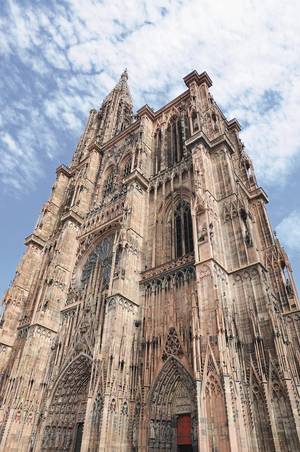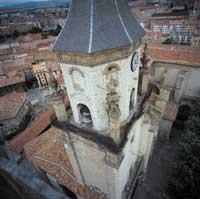Make light…!
2008/02/01 Lakar Iraizoz, Oihane - Elhuyar Zientzia Iturria: Elhuyar aldizkaria
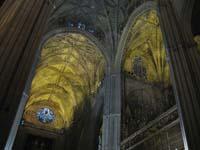
The Gothic cathedrals were the temples that expressed the most greatness in the Middle Ages; they were the tallest buildings built until then and at the same time seemed light, since the walls were full of holes: windows, rosettes, stained glass, etc.
But they did not start from day to day to build this kind of elegant and slender constructions. Gothic architecture emerges as a consequence of the evolution of Romanesque, when they managed to solve the biggest problem of Romanesque architecture. Probably a gothic architecture would not emerge if there had not been previous Romanesque architecture.
In turn, Romanesque architecture emerges as a solution to the biggest existing problem. That is, the Romanesque and the Gothic were part of a series of architectural styles that emerged as problems were solved and constructive techniques were perfected.
Romanesque contribution
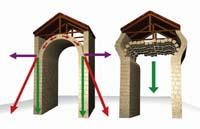
From its foundation to the 10th century, the main objective of Romanesque architecture was to extend the sustainability of the temples. Until then the churches and cathedrals had a great weakness with wooden roofs. Because of this, they were very vulnerable to fires; if the roof burned, the risk of falling was very high.
The builders proposed replacing wooden roofs with stone roofs. In this way, its duration would be longer, on the one hand because the stone does not rot and, on the other, because it is much more resistant to fire. In addition, stones were available anywhere, so they had no risk of material shortage.
To cover the stone ceilings, semicircular stone structures began to be built, with semicircular arches between two posts to cover the gap between two parallel walls, ceilings of the same shape (barrel vaults) and edge vaults to cover the gap between four walls or poles. The edge vaults are made by crossing two barrel vaults.
For the formation of such structures it was necessary to give the stones a wedge aspect, which was the most complicated work. The trained personnel were indispensable and groups of workers were created working stones for the roofs. They were traveling groups that moved from one place to another where churches were being built to supply wedge stones.
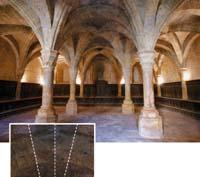
Although it seems simple, the construction of such churches was not any challenge. The existing buildings were designed to be wooden roofs and were too weak to hold a stone roof.
In an arch-shaped structure, the central stones of the arch or vault transmit force to the adjacent ones, to the adjacent ones, etc. Thus, the force resulting from the weight of the stones should reach the vertical supports of the arch or vault. That is, some stones should serve as support to the others, and the column, wall, etc. that holds the arch, should easily bear this weight.
But the workers who worked on that job saw that reality was not so perfect. Since each rock was independent of the previous one, and the surfaces that were touched were quite irregular, the weight transfer of the stones was not as direct as the one described. Part of the weight produced a destabilizing horizontal force: the push. By joining this horizontal thrust with the vertical force caused by the load of the stones, the ceilings ended up producing an oblique force.
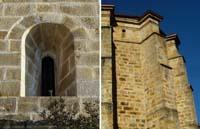
If the wall that had to support the arch was not thick enough to absorb the oblique force outward, or if it did not have a resistant structure to counteract it, it was destabilized and fell down. And there were few buildings that melted down for that reason.
Several ways were invented to solve this problem. On the one hand, they began to build much thicker walls. Due to the greater weight of the enlargement, the walls were able to absorb the oblique forces that were generated and keep the structures standing. On the other hand, the walls of the buildings already built had to be reinforced when they replaced the roofs. Buttresses were placed on the walls.
Another system with that objective was the half-barrel vault. As the word itself indicates, it was half a barrel vault, that is, half a tunnel. On both sides of a nave of a church a half-barrel vault was placed to divert the pressure exerted by the vault of that nave. It was very effective at the end of the same vault. In this way, it helped the wall that should support the vault, since it removed part of its weight.
Among all these structures, churches and cathedrals became large stone buildings. In two words, we can summarize a Romanesque building as a set of structures that provoke opposing forces. The walls were so thick and their function was so important that they could not open large windows. In fact, if perforated, the walls would lose their bearing capacity. Therefore, the windows and doors were as small as possible. And as a result, the churches were very dark. Thick, strong and dark.
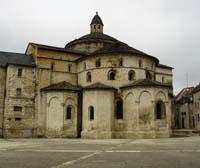
Next step: Gothic
Over the years construction techniques were fine-tuned and, little by little, new ways were invented to channel, absorb and alleviate forces. At one point they changed the appearance of the arches. All the structures that until then had semicircular shape were formed in pointed arch: the barrel vaults were built in pointed arch and were constructed similar to the edge vaults, which were formed with pointed arch barrel vaults. These new structures are known as cross-vaults.
This change seems small, but it was a breakthrough. It is what made it possible to move from one building style to another. The pointed arches transfer more vertically the load of the central stones, which allowed to reduce considerably the horizontal force of the thrust. Consequently, the walls should not be as thick as before, since even being thinner they were able to withstand the roofs.
They also found more effective ways to fight the forces. They saw that if the four pillars of the cross-vaulted vaults were joined by arches, the stones forming the vault each other transmitted the load to these arches. In this way it was possible to limit the strength of these vaults on the posts. It was a very important achievement, since only with reinforced or reinforced posts was enough to cancel the load of the entire vault.

To increase the strength of the posts, new buttresses developed: arbotantes. At the base they had the same function as the buttresses used in Romanesque architecture, but they were more effective: at the points where the ribbed vault was joined with four posts, two arches were built outward, forming a buttress or pillar at the other end of the arch to the ground. This support supported the weight of the vault.
Thus, the walls under the vault lost their support function. To cancel the push, it was not necessary to use the walls of the building, since the arbotantes located outside the building fulfilled this function. The builders realized that in this way they could greatly increase the height of the building and that the openings of the walls could increase whatever they wanted. Thanks to these innovations, the churches became large, luminous and slender buildings that until then could not imagine. And it became light.
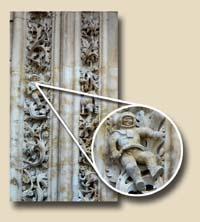

Gai honi buruzko eduki gehiago
Elhuyarrek garatutako teknologia





